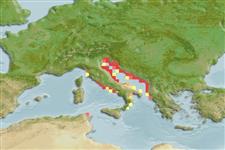>
Acipenseriformes (Sturgeons and paddlefishes) >
Acipenseridae (Sturgeons) > Acipenserinae
Etymology: Acipenser: Latin, acipenser = sturgeon, 1853 (Ref. 45335).
Eponymy: Fortunato Luigi Naccari (1793–1860) was an Italian philosopher, librarian and professor of natural history. [...] (Ref. 128868), visit book page.
More on author: Bonaparte.
Environment: milieu / climate zone / kisaran kedalaman / distribution range
Ekologi
laut; air tawar; payau dasar (demersal); anadromus (ruaya dari laut ke air tawar) (Ref. 51243); kisaran kedalaman 10 - 40 m (Ref. 93286). Temperate; 46°N - 37°N, 10°E - 20°E
Europe: Adriatic Sea and its tributaries between Po (Italy) and Buna (Albania) drainages. Recorded from Corfu; present in lowermost part of Adriatic rivers from Soca to Drin. Records from Tyrrhenian slope of Italy, Spain and France are erroneous.
Size / Weight / umur
Kematangan: Lm ? range ? - ? cm
Max length : 200 cm TL jantan/; (Ref. 3397); Berat maksimum terpublikasi: 25.0 kg (Ref. 3193)
Duri punggung (Keseluruhan (total)) : 0; duri punggung lunak (Keseluruhan (total)) : 36 - 48; Sirip dubur lunak: 24 - 31. Snout moderate, very broad and rounded at tip. Lower lip continuous, interrupted at center. Barbels nearer to tip of snout than to mouth and not touching it. Five rows of scutes, dorsal 10-14 (the middle ones deeper and usually larger than those at front), lateral 32-42 on each side, ventral 8-11 on each side, with no smaller plates between dorsal and lateral rows. Back is olivaceous brown, flanks lighter, belly white.
Body shape (shape guide): elongated; Cross section: circular.
Occurs in the sea close to shore and estuaries, not entering pure marine waters. In freshwater, it inhabits large deep rivers (Ref. 59043). A long-lived species which is found mainly over sand and mud. Feeds on bottom-living invertebrates and small fishes. Reproduction takes place from May to July. Is threatened by habitat destruction, pollution and overfishing (Ref. 26100). The flesh is used for food (Ref. 6866) and eggs used for caviar production (Ref. 128183).
Enters rivers from March to May, and presumably spawns then.
Kottelat, M. and J. Freyhof, 2007. Handbook of European freshwater fishes. Publications Kottelat, Cornol and Freyhof, Berlin. 646 pp. (Ref. 59043)
Status IUCN Red List (Ref. 130435: Version 2024-2)
ancaman kepada manusia
Harmless
penggunaan manusia
Perikanan: komersial
Alat, peralatan
laporan khas
muat turun XML
Sumber internet
Estimates based on models
Preferred temperature (Acuan
123201): 14.7 - 18.2, mean 17.4 °C (based on 12 cells).
Phylogenetic diversity index (Acuan
82804): PD
50 = 0.5000 [Uniqueness, from 0.5 = low to 2.0 = high].
Bayesian length-weight: a=0.00295 (0.00131 - 0.00665), b=3.18 (3.00 - 3.36), in cm total length, based on LWR estimates for this Genus-body shape (Ref.
93245).
Trophic level (Acuan
69278): 3.4 ±0.50 se; based on food items.
Daya lenting (Acuan
120179): sangat rendah, Waktu penggandaan populasi minimum lebih dari 14 tahun (Preliminary K or Fecundity.).
Fishing Vulnerability (Ref.
59153): Very high vulnerability (90 of 100).
🛈
Nutrients (Ref.
124155): Calcium = 16.9 [10.0, 29.8] mg/100g; Iron = 0.256 [0.156, 0.410] mg/100g; Protein = 17.5 [14.9, 20.1] %; Omega3 = 0.33 [0.18, 0.59] g/100g; Selenium = 18.3 [9.3, 35.5] μg/100g; VitaminA = 6.4 [2.3, 17.8] μg/100g; Zinc = 0.53 [0.38, 0.73] mg/100g (wet weight);
